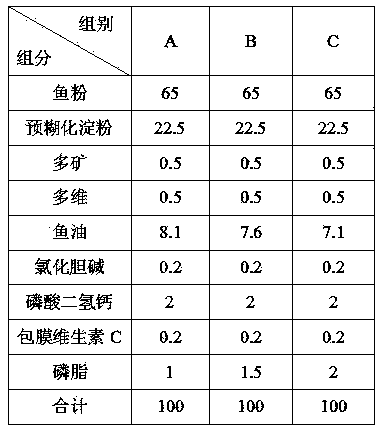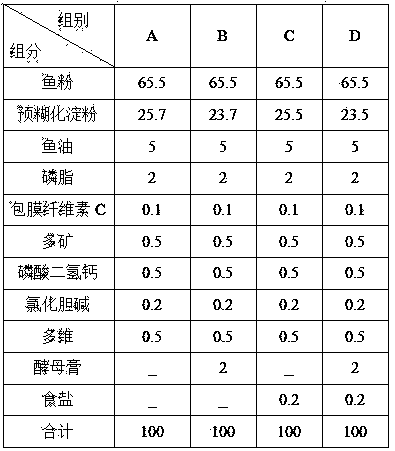Powdery compound feed for Anguilla bicolor in elver stage
A technology of compound feed and juvenile eel, applied in animal feed, animal feed, application, etc., can solve the problems of high bait coefficient, complicated preparation process, lack of high-quality feed formula, etc., and achieve the effect of improving breeding efficiency and reducing costs
- Summary
- Abstract
- Description
- Claims
- Application Information
AI Technical Summary
Problems solved by technology
Method used
Image
Examples
Embodiment 1
[0067] The components of the compound feed prepared in this example include: fish meal, pregelatinized starch, polymineral, multidimensional, fish oil, choline chloride, calcium dihydrogen phosphate, phospholipid, crystalline cellulose and coated vitamin C.
[0068] Above-mentioned components are made feed A, B, C, D, E and F group by different proportioning, and the percentage by weight of different components in each feed group is as follows:
[0069]
[0070] The feed was formulated according to the formula shown in the above table. The crude fat content of each group was the same, but the crude protein content was significantly different. The two-color eel juveniles were fed with the above-mentioned compound feed for 8 weeks, and the survival rate of the two-color eel juveniles in each group There was no difference between the feeds. The body weight growth rate of bicolor eels fed with feeds A, B, C, D, E and F were 28.94%, 28.63%, 27.23%, 50.22%, 42.96% and 54.5%, resp...
Embodiment 2
[0084] The processing technology of compound feed in the above-mentioned embodiment or comparative example is as follows:
[0085] (1) Raw material crushing: separate ultrafine crushing of each group of raw materials in the formula;
[0086] (2) Sieving: After crushing, the raw materials are sieved to ensure that the crushed raw materials pass through a 100-mesh sieve;
[0087] (3) Ingredients: weighing various raw materials in the formula after superfine grinding and sieving;
[0088] (4) Mixing: Stir and mix other components except fish oil, yeast extract, and phospholipid according to the composition of the formula, and mix the fish oil, yeast extract, and phospholipid with other components before mixing the two-color steamed buns;
[0089] (5) Weigh the package.
[0090] Special note: in order to improve the use time of the compound feed of the present invention, 0.02% ethoxyquinoline can be added in its feed components, and after adding ethoxyquinoline, the addition am...
PUM
 Login to View More
Login to View More Abstract
Description
Claims
Application Information
 Login to View More
Login to View More - R&D
- Intellectual Property
- Life Sciences
- Materials
- Tech Scout
- Unparalleled Data Quality
- Higher Quality Content
- 60% Fewer Hallucinations
Browse by: Latest US Patents, China's latest patents, Technical Efficacy Thesaurus, Application Domain, Technology Topic, Popular Technical Reports.
© 2025 PatSnap. All rights reserved.Legal|Privacy policy|Modern Slavery Act Transparency Statement|Sitemap|About US| Contact US: help@patsnap.com


